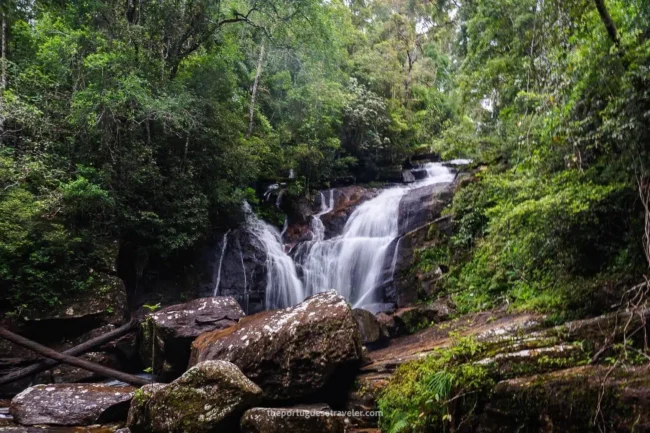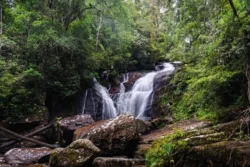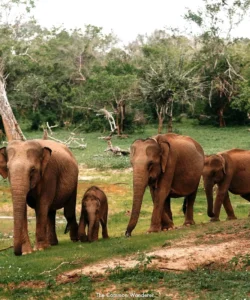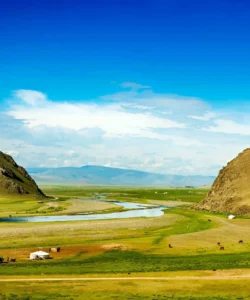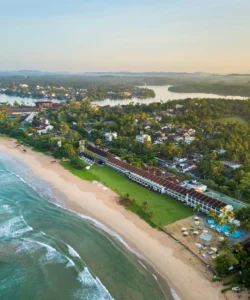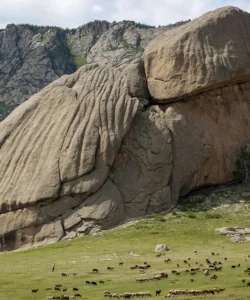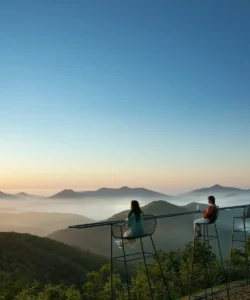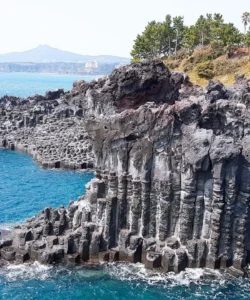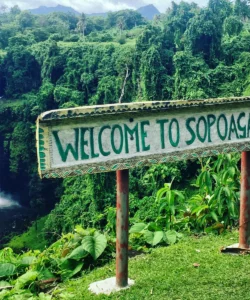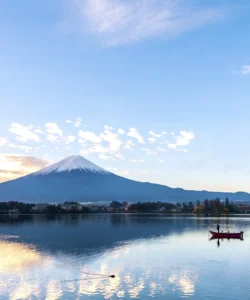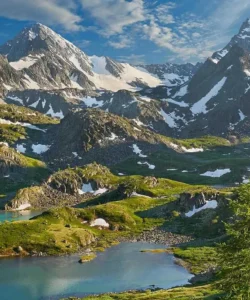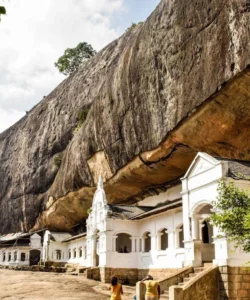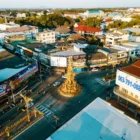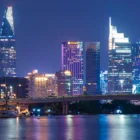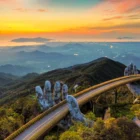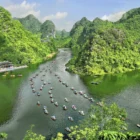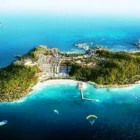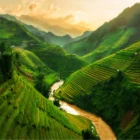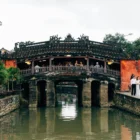The Sinharaja Forest Reserve (සිංහරාජ වැසි වනාන්තරය) is Sri Lanka’s last viable area of primary tropical rainforest. Located in the southwest lowlands of the island, it is a magnificent testament to ancient Gondwanaland forests, teeming with an extraordinary array of endemic flora and fauna. As a UNESCO World Heritage site and a Biosphere Reserve, Sinharaja is globally recognized for its outstanding universal value in preserving biodiversity, offering a profound glimpse into a unique and ancient ecosystem.
Name: Sinharaja Forest Reserve (Sinhara-raja, meaning “Lion King”). The name is associated with the island’s legend of the origin of the Sinhalese people from a union between a princess and a lion.
Address: Southern and Sabaragamuwa Provinces, Sri Lanka. The main entrance points are generally via the towns of Deniyaya (southern side) and Kudawa/Weddagala (northern side). Kudawa is the more common entry point for tourists.
How to get there:
Reaching Sinharaja Forest Reserve typically involves getting to Sri Lanka (Colombo) and then traveling to its relatively remote location in the southwest:
- From Colombo (Bandaranaike International Airport – CMB) to Sinharaja (Kudawa/Deniyaya):
* Taxi/Private Car: The most comfortable and relatively fastest way. To Kudawa (northern entrance), it takes approximately 3.5-4.5 hours (around 150-160 km). To Deniyaya (southern entrance), it’s a bit further, taking around 4-5 hours. You can pre-book a transfer.
* Bus: Take a bus from Colombo to Kalawana (for Kudawa entrance, approx. 3 hours) or Deniyaya (for southern entrance, approx. 4-5 hours). From Kalawana/Deniyaya, you’ll need a local bus or tuk-tuk to the specific entrance village (Kudawa/Pitadeniya). This is more budget-friendly but involves transfers and can be time-consuming.
* Train + Bus/Taxi: Less direct. You can take a train to a town like Matara (on the south coast) or Ratnapura (inland), then take a bus/taxi from there. - Within Sinharaja: Access is strictly controlled. Visitors must enter with an approved guide (often arranged through your guesthouse or the park office). Exploration is done on foot via designated trails, as vehicles are not allowed deep into the reserve.
Operating Hours and Entrance Fee:
- Operating Hours: Generally open daily from 6:00 AM to 6:00 PM.
- Entrance Fee: For foreign visitors, there is a per-person entrance fee (typically around $10-15 USD plus taxes and service charges, subject to change). There’s also a fee for a mandatory guide and sometimes a nominal fee for vehicle parking outside the gate.
Landscape and Architecture:
Sinharaja’s “architecture” is its dense, multi-layered primary rainforest, largely untouched by significant human construction:
- Dense Primary Rainforest: The park is predominantly covered by dense, humid, multi-layered tropical lowland rainforest, characterized by a closed canopy, an emergent layer of towering trees, a sub-canopy, understory, and forest floor. This rich stratification creates a dark, humid, and acoustically vibrant environment.
- Mountainous Terrain: The forest is situated on a series of undulating ridges and valleys, with small streams and waterfalls dissecting the landscape. The highest peaks are Sinhagala (742 m) and Hinipitigala (1,171 m).
- Waterfalls and Streams: Numerous clear streams and small waterfalls cascade through the forest, vital for its ecosystem.
- Unique Flora: The forest is a botanical wonderland, with an incredibly high level of endemism. Many tree species grow exceptionally tall and straight, forming a dense canopy. Diverse ferns, mosses, orchids, and medicinal plants thrive in the humid conditions.
- Unobtrusive Trails: The human “architecture” consists of relatively narrow, sometimes muddy, walking trails designed to be as unobtrusive as possible, allowing visitors to immerse themselves in the forest without extensive man-made structures.
- Research Stations/Field Centers: Small, basic field research stations or ranger posts exist at the entrance points.
- Abundant Leeches: A notorious “feature” of the forest, particularly during and after rain, requiring visitors to wear appropriate protection (leech socks).
- Wildlife (The Main Draw): Sinharaja is a biodiversity hotspot, home to:
- High Endemism: Over 60% of Sri Lanka’s endemic tree species, and many endemic birds, mammals, and reptiles.
- Birds: Famous for its mixed-species feeding flocks of birds, including many of Sri Lanka’s endemic bird species (e.g., Sri Lanka Blue Magpie, Red-faced Malkoha, Green-billed Coucal, Serendib Scops Owl). It’s a birder’s paradise.
- Mammals: While larger mammals like leopards are extremely rare and difficult to spot, the forest is home to purple-faced langurs, slender lorises, giant squirrels, sambar deer, and various smaller endemic mammals.
- Reptiles & Amphibians: A high diversity of endemic reptiles and amphibians, including various tree frogs and lizards.
- Insects and Butterflies: A rich array of invertebrates.
What makes it famous:
Sinharaja Forest Reserve is famous for:
- UNESCO World Heritage Site: Designated in 1988, recognized for its outstanding universal value as a primary tropical rainforest with a high degree of endemism, making it a critical site for global biodiversity conservation.
- Last Viable Primary Rainforest in Sri Lanka: It holds immense significance as the largest and most ecologically intact remnant of Sri Lanka’s once-extensive tropical rainforests.
- Exceptional Endemism: It boasts an incredibly high percentage of endemic species of flora and fauna, meaning species found nowhere else on Earth. This makes it a unique biological treasure.
- Mixed-Species Bird Flocks: It’s particularly famous among birdwatchers for its phenomenon of large, dynamic mixed-species feeding flocks, which contain many of Sri Lanka’s endemic bird species.
- Immersive Rainforest Experience: Visitors can experience the sights, sounds, and smells of a dense, untouched tropical rainforest, a profound connection with nature.
- Rainforest Trekking: Offers guided treks through its diverse layers, suitable for varying fitness levels.
- Conservation Success Story: Despite past logging activities, its protection has allowed the forest to regenerate, showcasing a successful conservation effort.
Differences from some other wonders:
Sinharaja Forest Reserve distinguishes itself from other national parks and natural wonders in several key ways:
- Primary Rainforest (Lowland Wet Zone): While Sri Lanka has other national parks (e.g., Udawalawe for elephants, Yala for leopards, Horton Plains for montane forests), Sinharaja is specifically famous for being a lowland, primary tropical rainforest. This distinct ecosystem, with its high humidity, multi-layered canopy, and unique flora, sets it apart from dry zone safaris or high-altitude plains.
- Foot-Based Exploration Only: Unlike most Sri Lankan national parks that primarily offer jeep safaris, Sinharaja is explored exclusively on foot with a guide. This allows for a much more intimate, slow-paced, and immersive experience of the forest’s smaller creatures, birds, and intricate botanical details.
- Extreme Endemism and Biodiversity Hotspot: Its exceptionally high levels of endemism across various taxa (trees, birds, amphibians, reptiles) make it a globally significant biodiversity hotspot, a focus that differentiates it from parks known for specific large mammals.
- Acoustic Immersion: The dense canopy and humid environment create a unique acoustic landscape, dominated by the sounds of insects, birds, and dripping water, offering a profoundly different sensory experience compared to open savannas or bustling cities.
- “Living Relic” of Gondwanaland: Geologically, it’s considered a remnant of the ancient Gondwanaland supercontinent, giving it a unique evolutionary history as a “living fossil” of prehistoric forests.
- Challenging Conditions (Leeches, Humidity): The very elements that define its rainforest nature (humidity, rain, leeches) contribute to a more rugged and challenging experience compared to other, often drier or more manicured, natural attractions, adding to its authentic wilderness appeal for some.
In essence, Sinharaja Forest Reserve is a precious and extraordinary wonder, a vital remnant of ancient rainforest that offers an unparalleled immersion into Sri Lanka’s rich and unique biodiversity, making it a profound and unforgettable journey into the heart of a living, breathing natural heritage.
